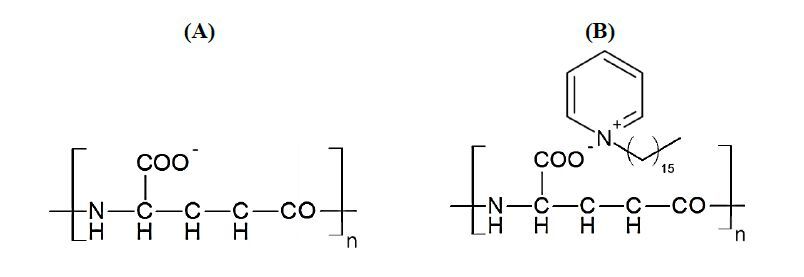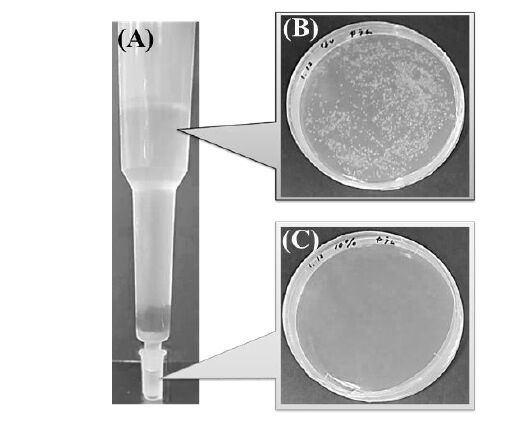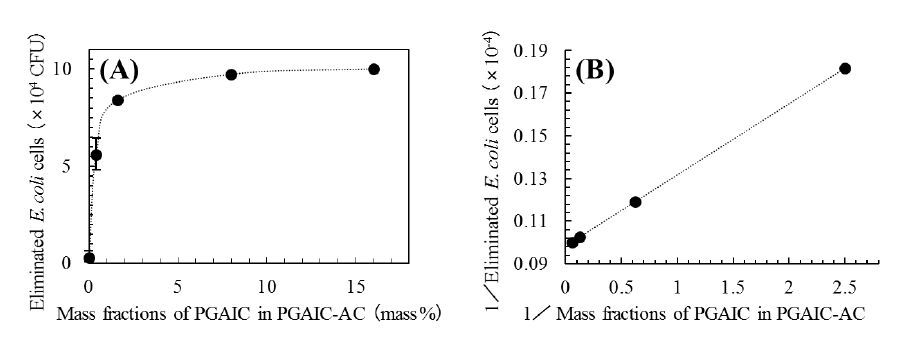1. Introduction
The availability of clean water is a fundamental necessity for life and the pollution of water supplies is therefore a serious health issue. Organic chemicals, heavy metals, and some microbes are possible water pollutants. In particular, water-borne pathogens can lead to illness, often including symptoms such as abdominal pain, diarrhea, and fever [1]. Diarrheal disease can be life threatening in developing countries where medical treatment may not be available. In a survey of World Health Organization, diarrhea was ranked the third cause of death in low-income economies [2]. Even in Japan, which is equipped with advanced water purification systems, 1,500 individuals reported infections from water-borne pathogens in the past 10 years [3]. There is therefore an urgent need for the development of new methods of pathogen elimination that are effective, simple to perform, and cost efficient.
The multi-porous structures of active carbons have the potential for adsorption of comparatively small compounds such as volatile toxins, dye chemicals (e.g., bromophenol blue), and metal ions [4], but are unlikely to eliminate pathogens (e.g., bacteria, fungi, viruses) from water. Accordingly, active carbons are ineffective as a material for providing safe (clean) water.
Poly-γ-glutamate (PGA), a hybrid-type polymer with a nylon-like backbone and polyacrylate-like side-chain structures (Figure 1A), has reasonable biodegradability and good biocompatibility [5]. We recently succeeded in the plasticization of water-soluble (or hygroscopic) PGA from Archaea [6], hereafter referred to as novel, bio-based, plastic PGA ion complexes (PGAICs) (Figure 1B). PGAICs serve as the coatings for multiple infection prophylaxes (i.e., bactericides, antifungals, and antivirals), being able to functionally transform a range of different surfaces on plastics, metals, and ceramics [7]. However, it is still unclear whether active carbons could serve as the base material (or substrate) for the surface coating of PGAICs.
Here, we present the synthesis of a novel bacteria-elimination material, i.e. PGAIC-coated active carbons (PGAIC-AC). In this study, the potential of the PGAIC-AC system was also examined using Escherichia coli JM109 as a laboratory model of a water-borne pathogenic bacterium because E. coli is used worldwide as a fecal indicator species to assess the quality of (drinking) water [8].
2. Materials and Methods
2.1. Materials
Bromophenol blue (BPB) and granular active carbons (AC) were purchased from Nacalai Tesque (Kyoto, Japan). A compound used in toothpaste, hexadecylpyridinium cation (HDP+), was obtained from Tokyo Chemical Industry (Japan) to synthesize water-insoluble PGAIC. A POLYPREP column was from Bio-Rad Laboratories (Hercules, CA). All other chemicals were of analytical grade.
2.2. Bacterial strain, media, culture conditions
A soybean-casein digest broth DAIGO (Nihon Pharmaceutical, Tokyo, Japan) was utilized for the cultivation of E. coli JM109 (Wako Pure Chemicals, Osaka, Japan). When the turbidity at 600 nm of the culture reached 0.8, 5 mL of the broth was centrifuged at 8,000 × g for 10 min. The harvested cells were suspended into 5 L of sterilized water to prepare a laboratory model of water-borne E. coli (~ 2.0 × 104 CFU/mL) [9]. The model suspension of E. coli (0.1 mL) was spread onto a DAIGO agar (Nihon Pharmaceutical) plate and incubated at 37 °C for 12 h to count the number of E. coli colonies, viz. the direct plating method for enumeration of living cells [10,11]. When > 300 colonies were formed on a plate, the samples were additionally diluted to 10 times and re-subjected to the enumeration tests.
2.3. Production of archaeal PGA
A PGA-producing hyper-halophilic archaeon, Natrialba aegyptiaca was inoculated into 200 mL of S medium (pH 7.2) comprising 25% NaCl, 0.2% KCl, 1% trisodium citrate, 1% yeast extract, and 0.75% casamino acids, cultured at 37 °C for 4 days, before being harvested by centrifugation (8,000 × g, 30 min) at room temperature (~ 25 °C). The harvested cells (0.4 g) were cultured on a 2% agar plate (145 mm dia.) of S medium (50 mL) at 37 °C for 2 weeks. Extracellular PGAs were collected along with growing cells from the solid-culture system using 10 mL of 25% NaCl solution, and centrifuged at 8,000 × g for 30 min. The supernatant was further injected onto a QMA anion-exchange cartridge [12], which was washed with 10 mL of water, followed by 5 mL of 0.5 M NaCl solution. Archaeal PGA (Mw, ~ 800,000) was subsequently eluted with 5 mL of 0.7 M NaCl solution.
2.4. Syntheses of PGAIC and PGAIC-AC
Water-insoluble PGAIC was formed via mixing a 2 wt% solution of PGA with HDP+ solution (ca. 120 mol% of the carboxyl groups contributed by PGA molecules) [6]. The pellets were collected by centrifugation, washed with water at 60 °C, and lyophilized. PGAIC (2.0 g) was dissolved in 10 ml of desterilized ethanol (> 99.5 wt% EtOH). This PGAIC/EtOH solution was further diluted to 1, 5, and 10 wt% concentrations of PGAIC. Desterilized EtOH was used as the control. In the tests, 0.8 mL of these solutions were added to 0.5 g of active carbons to synthesize PGAIC-ACs, in which 8, 40, and 80 mg of PGAICs were theoretically served as the surface coatings, respectively.
2.5. Bromophenol blue (BPB) assay
The calibration curve for determination of BPB salts is as follows: y = 0.071x, where y represents an increase in absorbance at 590 nm and x corresponds to BPB concentration (mg/mL), and was linear over the range 2-12 mg/mL. Active carbons (AC) display adsorption capacities to BPB [13]. Actually, in the absence and presence of AC (50 mg) in a 0.1 wt% solution (1.0 mL) of BPB, the absorbance values of the resulting supernatants after incubation for 24 h were calculated to be 0.67
× 103 and 0.95 × 102; therefore, the BPB-adsorption capacity of AC was estimated as 16 mg/g.
2.6. Escherichia coli-elimination tests
In these tests, 50 mg of native AC and three PGAIC-ACs, each at concentrations of 0, 0.8, 4, and 8 mg of PGAIC, were added to 5 mL of the model suspension of E. coli. This bacteria-elimination process could be terminated within 1 min (until these AC materials reached the bottom of test tubes, for instance). Furthermore, we prepared a PGAIC-AC-embedded column using 0.1 g of PGAIC-AC (carrying 16 mg of PGAIC) and a POLYPREP column. A native-AC-embedded column was used as the control. Five mL of the model suspension was passed through these AC columns, and residual E. coli cells were determined by counting the colonies thus formed (as described in the section 2.2).
2.7. Equilibriumstudies using a modified Langmuir model
Generally, adsorption is defined as the transfer of a target (viz., E. coli cells) from a liquid phase to a solid phase via the formation of specific interactions with an absorbent (viz., PGAIC-AC) [14]. In this study, a modified Langmuir model (Eq. 1) [12,15], which uses the dissociation constant Kd that refers to as the reciprocal of Langmuir (association) constant, was employed to reveal the function of the antimicrobial agent PGAIC on PGAIC-AC materials.
The linearized form of the Langmuir-based equation is shown below (Eq. 2).
where the qe and Q0 values correspond to the eliminated and initial cell counts of E. coli tested. Five mL of the laboratory model, therefore, contains initially 105 CFU of the microorganisms. Further, the Ce values indicate the mass fractions of PGAIC to PGAIC-AC materials tested (mass %).
3. Results
3.1. BPB-adsorption capacities of PGAIC-ACs
First, to assess whether or not the surfaces of AC particles were coated with the PGAIC materials as described above (see section 2.4), we examined the BPB-adsorption capacities of PGAIC-AC. The PGAIC-ACs harboring 16, 80, and 160 mg/g weight ratios of PGAIC gave adsorption capacities of 13.2, 7.8, and 6.4 mg/g, respectively. Because the capacity of native AC was found to be 16 mg/g, an increase in the amount of PGAIC coating resulted in a decrease in their BPB adsorption capacity, presumably owing to a partial blockage of the dye-binding sites in ACs [13] via the surface coating of PGAIC. PGAIC-AC materials had therefore been successfully synthesized and the PGAIC coating mediated its effects in a dose-dependent manner, even for a complex surface such as AC.
3.2. Bacteria elimination using PGAIC-ACs
Next, thesePGAIC-AC materials were subjected to a bacteria-elimination test using E. coli, and the log reduction values in the PGAIC-AC materials relative to the AC particles were shown in Table 1. The results revealed the potential of PGAIC-AC as a useful bacteria-elimination material; however, there was still room for improvement in this procedure because the water-borne E. coli cells had not been completely eliminated.
Table 1.Bacteria elimination using PGAIC-ACs as dispersant
| Agent amounts (mg) a
|
Residual E. coli cells (CFU/mL) b
|
Titer reduction (log)
|
|
0
|
2.06 ± 0.27 (× 104)
|
-
|
|
0.8
|
1.21 ± 0.98 (× 103)
|
1.23
|
|
4
|
9.40 ± 6.70 (× 102)
|
1.34
|
|
8
|
3.80 ± 2.70 (× 102)
|
1.73
|
a Net amounts of PGAIC coatings (as anti-E. coli agent) in 50 mg of PGAIC-ACs thus used.
b Given as the means ± the standard deviations of 10 independent tests. |
Moreover, an E. coli-elimination test was performed using the PGAIC-AC-embedded column (see section 2.6). As shown in Figure 2, the water-borne E. coli cells appeared to be eliminated by passing through the column. PGAIC-ACs with different amounts of PGAIC coating were then applied to the column system, and the elimination tests were repeated (Table 2). An increase in the amount of PGAIC coatings resulted in an increase in the E. coli elimination ratios, implying that, unlike the use of PGAIC-AC as a dispersant, bacterial elimination could be controlled in a dose-dependent manner when PGAIC was used as a functional carrier on the closed spaces in such column-like structures.
Table 2.Bacteria elimination using a PGAIC-AC-embedded column
| Agent amounts (mg) a
|
Residual E. coli cells (CFU/mL) b
|
Titer reduction (log)
|
|
0
0.4
|
2.13 ± 0.31 (× 104)
9.95 ± 2.20 (× 103)
|
-
0.33
|
|
1.6
|
4.33 ± 3.50 (× 103)
|
0.69
|
|
8
|
5.40 ± 3.70 (× 102)
|
1.60
|
|
16
|
0
|
> 4.29
|
a Net amounts of PGAIC coatings (as anti-E. coli agent) in 50 mg of PGAIC-ACs thus used.
b Given as the means ± the standard deviations of 10 independent tests. |
Based on the data of Table 2, we plotted the eliminated E. coli cells from the laboratory model (5 mL) against the mass fraction of PGAIC to the PGAIC-AC materials in the column of Figure 2A (0.1 g), and focused on the description of a hyperbolic curve (i.e., a non-linearity) (Figure 3A). The equilibrium data were in fact fitted to Langmuir adsorption model (Figure 3B). The PGAIC-AC materials, therefore, would involve PGAIC-coated functional surfaces to bacteria elimination in a contact (or adsorption) killing-dependent manner.
4. Discussion
In Japan, the numbers of bacterial cells in river, sea, groundwater, and tap water are considered to be 102-105, 10-104, 0-104, and 0 CFU/mL, respectively. Generally, only fresh (raw) water containing < 50 CFU/mL (nearly equal to 5 × 103 MPN/100 mL [9]) of E. coli can be used for the purification process to manufacture drinking water. The PGAIC-AC system developed in this study would aid the effective elimination of water-borne E. coli and improve the quality of the water supply. Because the PGAIC-coating materials can function as anti-staphylococcal agents, antifungals, and antivirals [7], PGAIC-ACs might ensure prophylaxis of multiple water-borne infections.
In the Mekong river basin of Laos and Cambodia, safe (drinkable) water is available for only 51% and 41% of the population, respectively [16,17]. Hence, diarrheal disease, as a result of water-borne pathogens, causes a serious threat to human health in both of these regions [18]. E. coli and coliform bacteria were detected at ~ 1.3 × 103 MPN/100 mL of water from the Mekong [19], revealing the need for water purification. The PGAIC-AC system can be utilized to purify water urgently in conditions where no electricity or specialized equipment is available.
5. Conclusion
We focused on the performance of PGAIC as an antimicrobial coating material and succeeded in the development of PGAIC-ACs for effective bacterial elimination. Viable E. coli cells were virtually eliminated (> 99.9%) from the laboratory model of highly contaminated water (~ 2.0 × 104 CFU/mL) using our PGAIC-AC-embedded column. We hope that the PGAIC-AC system serves to regenerate the resources of water from such undesirable (polluted) conditions, and the large-scale manufacture of PGAIC-AC products would now be required for in situ water purification.
Conflict of Interest
All authors declare no conflict of interests in this paper.










 DownLoad:
DownLoad: 







